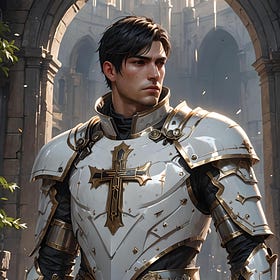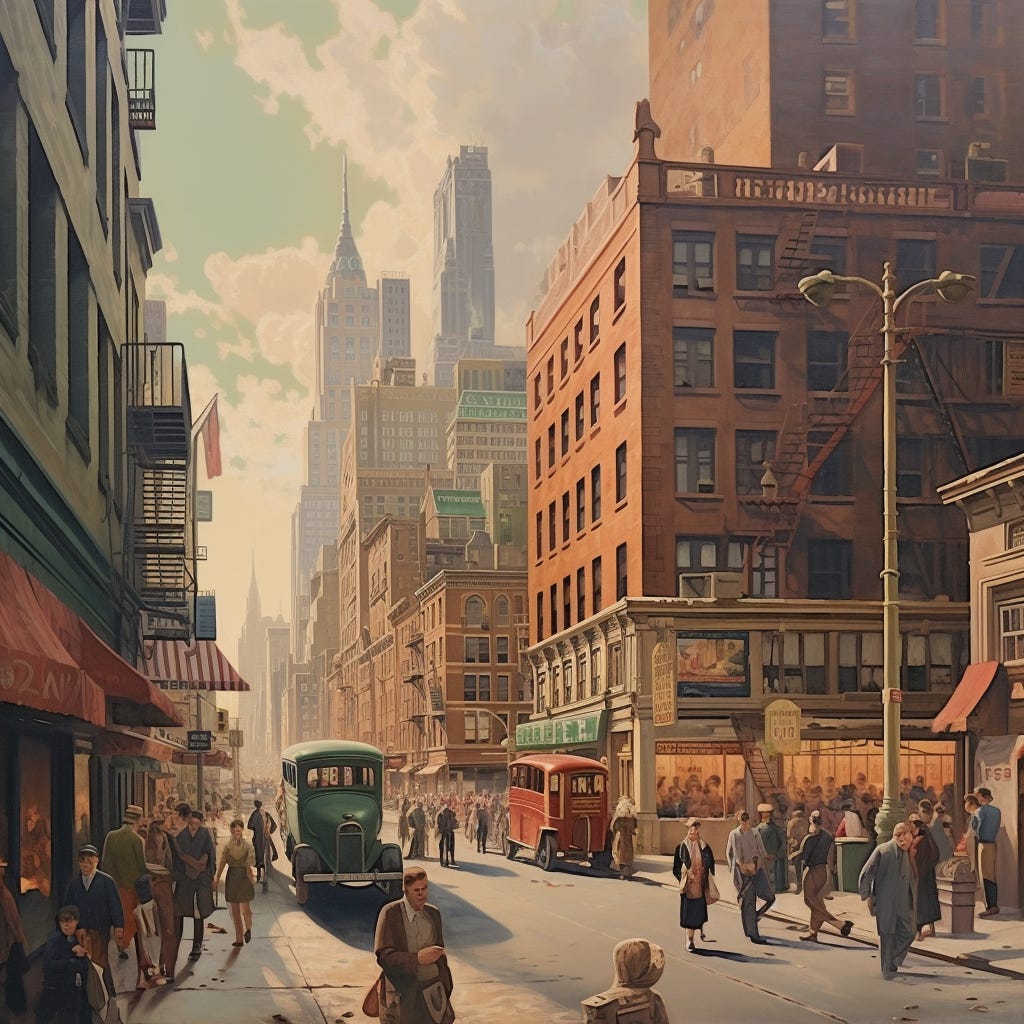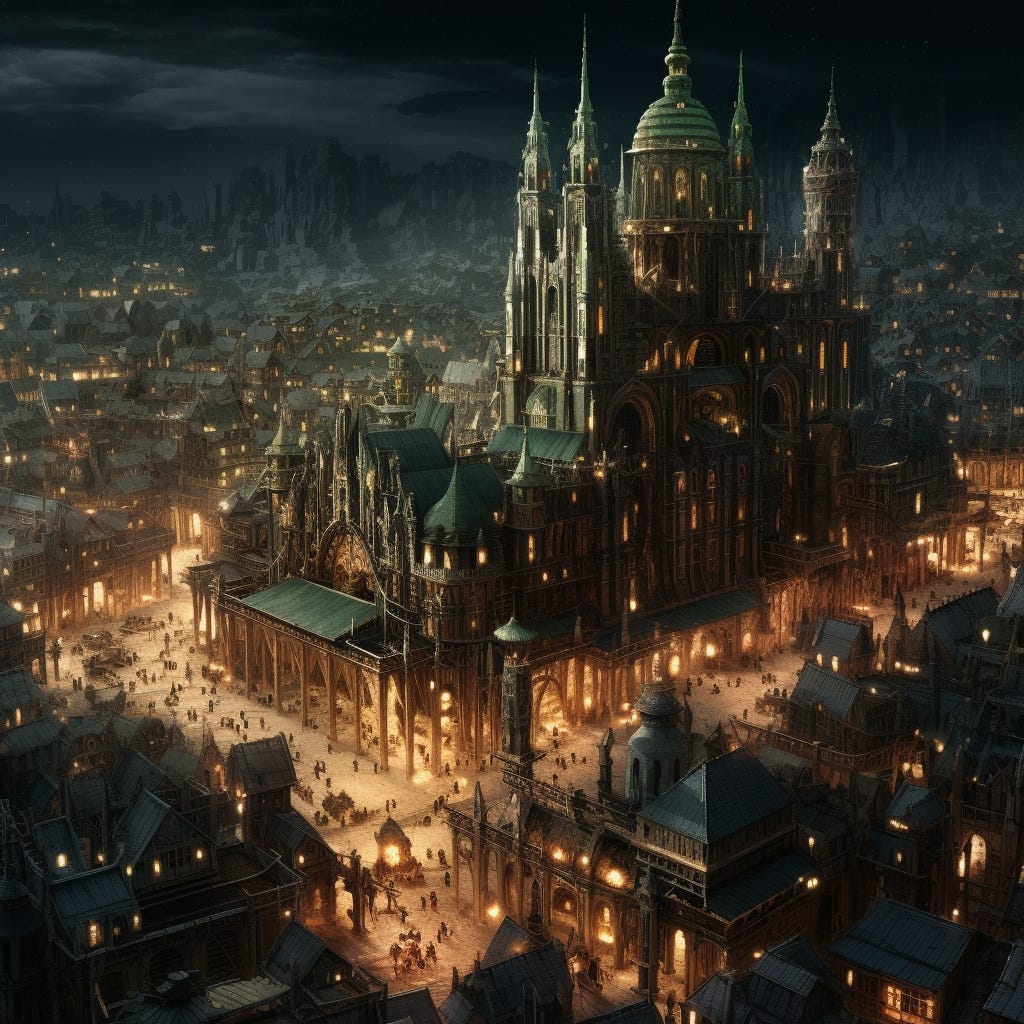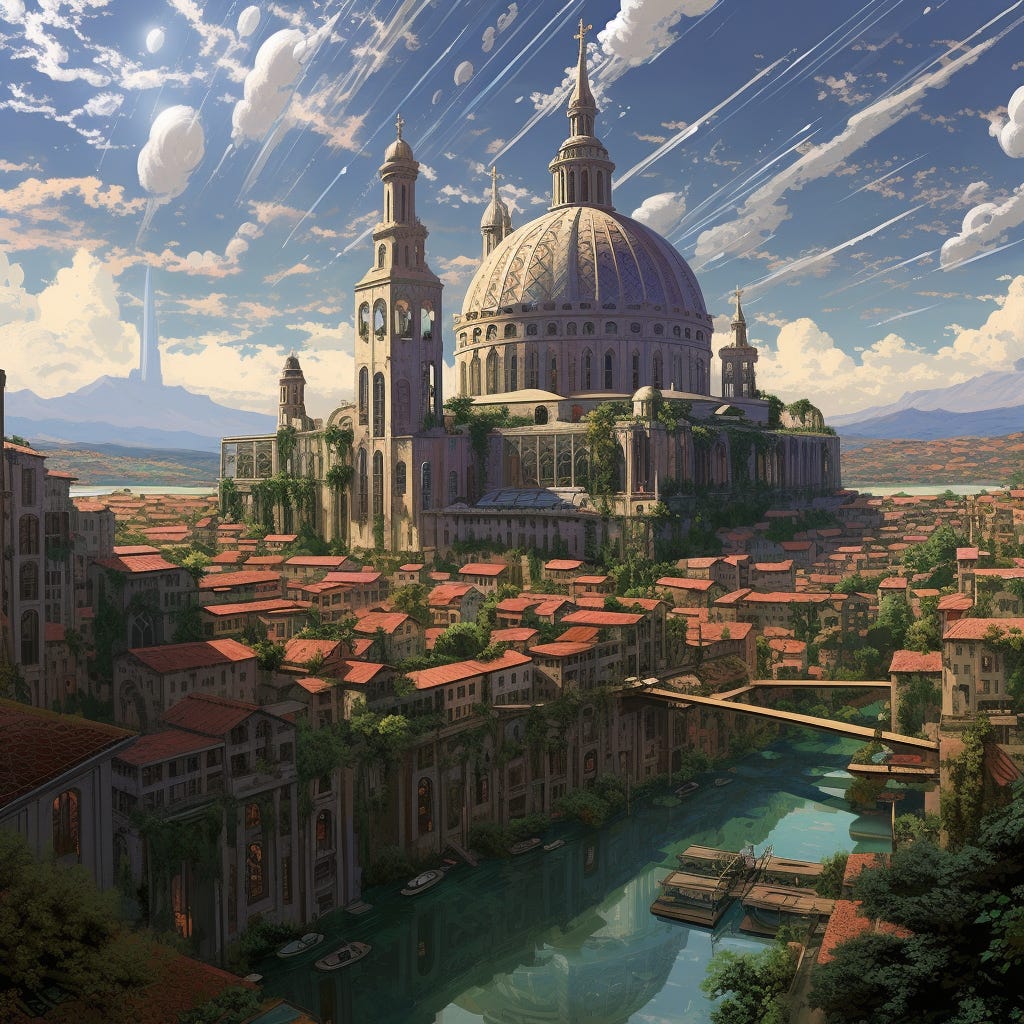The Holy League Universe
An introduction to the Holy League Universe. 14,000 years of history in a single post.
Foreword
Welcome to my latest long-running project. With Inquisitor’s Promise done as a web novel, I’ll be working on some more editing and other work for its final release (probably on Amazon but we’ll see). Meanwhile, I want to build up on the world surrounding that novel with a series of short stories and serials.
The Holy League Universe is the name I gave to the greater universe that Inquisitor’s Promise takes place in. As I said in the blurb, there’s 14,000 years of history upon which that novel is but a piece of this tapestry.
My goal is to portray a universe where human free will and heroism matters. Wish me luck!
What is this post exactly?
This post serves two functions. The first is to be an index for all the stories that I’ve written in this Substack that takes place in the Holy League Universe. This, of course, includes Inquisitor’s Promise. Each of these stories will be placed in a chronological order.
The second function of this post is to show the timeline of the Holy League universe. There are various eras that each time are divided into. As more stories set in the Holy League Universe are published in this Substack, they will be put in the index below.
As an aside, I’d like to give
a shout-out for his post “on time” which inspired me to make this post. Though I came up with the eras, the idea of putting a single post for the whole thing is from that.The Flow of History
The flow of history is popularly understood in two ways:
The first is the progressive view of history wherein history is on an ever-upwards march until we reach utopia or the singularity or “the end of history”. This is the view of progressive liberals, Marxists, and trans-humanists who gush about AI.
The second is the cyclical view of history in which history keeps going around in circles. There are periods of ups followed by down and it keeps on going. This is the view of the ancient Greeks, the Hindus, and many dissident right-wing folks.
I believe that both views are both wrong and right in their own ways. Yes, “there is nothing new under the sun” as King Solomon had written. There is also a cycle of the rise and fall of civilizations. You’d have to be blind not to see the cycle of civilizations in human history.
On the other hand, there is an upward movement in history. As a Christian, I have to believe it because we know that history before Christ and after Christ is not the same. As a Catholic, I have to believe that there is a development within the Church. And as we speak, we are moving ever closer towards Kingdom Come.
This is the flow of history that I use for the Holy League Universe.
Disclaimer: This should go without saying, but I might as well get it out of the way - I don’t have a crystal ball, nor am I a mystic. I’m just a fiction writer. And this is just my sandbox, that’s all.
UPDATE 7/9/2024: Some stories here are available only to paid subscribers. They are marked with an asterisk (*).
UPDATE 7/20/2024: I’ve put together an image gallery to (further) visualize the Holy League Universe. I plan to add more images as time goes, so do keep an eye on it…
History of the Universe
The history of the universe is divided into many ages. Each of these ages are of varying lengths, ranging from a few days to a few thousand years.
Age of Creation
[6 Days of Creation plus 1 of Rest - Circa 5199 BC]

The Age of Creation refers to the period in which God created the entire universe.
In the beginning, God created the Heavens and the Earth, as Moses had recounted in the Book of Genesis. The Earth, a special place in the universe, was created first while the physical heavens as we know it, known as the Firmament, was created later in the Second Day. All in all, the creation process took six days, which included the creation of Man, or Adam, on the Sixth Day in the Garden of Eden. This period also included the Seventh Day in which God rested.
The Age of Creation ended with the Fall in which the sin of Adam severed humanity from God.
Stories taking place in the Age of Creation:
The First Story (The Beginning) (Flash Fiction)
Antediluvian Age
[52nd Century BC to 33rd Century BC]
The Antediluvian Age comes after the Age of Creation. It lasted almost twenty centuries until the Days of Noah.
After the Fall, sin entered the world. After leaving Eden, humanity spread around the world. During this time, humanity lived a very long time, most could live for hundreds of years. This was possible through a combination of the still pristine human genetics and a better atmosphere for the Earth. During this time, the Earth had one supercontinent known as Pangaea. Furthermore, the wildlife during this time period tend to be much bigger.
Some parts of the Antediluvian civilization were highly advanced, the long-lived men were able to master knowledge that their shorter-lived counterparts couldn’t. However, man’s evil grew as the centuries passed. Eventually, God saw fit to flood over the whole world in water. The only survivor of this cataclysm was Noah and his family.
The Great Flood changed the face of the Earth. The idyllic Pangaea of old was gone. The cataclysm also affected outer space and created the Electrosphere. Located in the space between the Earth and the Moon, the Electrosphere was a mirror dimension in which inhabitable planets are located.
Postdiluvian Age
[33rd Century BC to 1st Century BC]
The Postdiluvian Age comes after the Antediluvian Age. It is also known as the “Old Testament Era” as it is the Age that directly preceded the Birth of Christ.
After the Great Flood that wiped out the vast majority of humanity, Noah and his family started humanity over. In the period after the flood, an Ice Age followed which covered much of the Earth in ice, causing the oceans to recede; this period lasted for a few centuries. Eventually, the Ice Age ended; much of the ice caps melted, the oceans expanded, and many old lands were sunk.
As for humanity, they spread all around the Earth. Some even made their way to the Electrosphere through either preternatural means or long-lost technology. Regardless, they continued to yearn for the transcendent which they could not achieve. Their attempts to understand their past and their relationship with the Divine was known as mythology. More learned men used philosophy instead. But God’s own plan for the savior continued on from Abraham through the Nation of Israel and culminated in the Birth of Christ.
Stories taking place in the Postdiluvian Age:
Adventures in Balkania (Time Unknown) (Novelette)
The Santara Commentaries (Time Unknown) (Serial)
Life of Christ (The Great Division of History)
[1st Century AD]

The Birth of Christ ushered in the Great Division of History. From this point on, history was divided into BC (Before Christ) and AD (Anno Domini – The Year of Our Lord).
During this time, Christ was born, He walked on this Earth, and He was crucified under Pontius Pilate. However, He rose again from the dead and later ascended into Heaven. After this, the world was never the same again. The Logos Incarnate had entered into the world and founded His Church upon the rock of St. Peter. From this point on, the Universal Church is the vehicle of God’s movement through history, a change from the ethnically based Nation of Israel.
The Era known as the Great Division of History ended at 70 AD through the Destruction of the Temple in Jerusalem by the Roman Empire. While the Crucifixion showed the changing of the guard from the Temple to the Church, the Destruction of the Temple made it apparent to everyone.
Age of Terra
[1st Century to 22nd Century]
From this point on, it was said that the End Times had begun. With the Ascension of Christ into Heaven and the Descent of the Holy Spirit during Pentecost, it was only a matter of time before the End of the Age. However, God’s movement through history may seem slow in human eyes.
The Age of Terra is the first age since the Great Division of History. The name comes from the fact that humanity at large remained rooted to Earth. They are generally ignorant of the world at large and have no idea of the Electrosphere. The general ignorance of the cosmos was such that they even entertained the idea that the Sun was the center of the universe.
This Age ended when humanity started to regularly travel beyond the Earth towards outer space. This truly began in the earnest in the 22nd century.
Stories taking place in the Age of Terra:
A Heist in Goa (22nd Century) (Short Story)
Age of Exploration
[22nd Century to 31st Century]
While there had been space explorations by unmanned probes and landings on the Moon prior to the Age of Exploration, regular space travel only happened since the 22nd Century with the development of the Electro-travel. This was only possible when a new paradigm in physics developed. Scientists realized that the speed of light was not constant. Furthermore, they discovered the great role of electricity in the cosmos that they hadn’t realized before. Finally, they learned that the universe was smaller than they had once believed.
This “Great Paradigm Shift” in physics allowed actual space travel. However, they soon found that all of the planets they had discovered were barren. This seemed to prove the specialness of both humanity and the Earth.
But then humanity of Earth discovered Electrosphere Portals which took them to the mirror dimension where inhabitable planets abound. Termed “The Great Discovery”, the Terrans not only learned of inhabitable planets, but they also made contact with their long-lost cousins, their fellow descendants of Adam in space.
With that, Earth started to establish colonies in the Electrosphere. But in time, the colonies grew strong as did the native powers of the Electrosphere. Soon, Earth began to be relegated into a footnote of interstellar politics. This marked the end of the Age of Exploration.
Stories taking place in the Age of Exploration:
Thunderbird (23rd Century) (Flash Fiction)
Message From Arcturus (23rd Century) (Flash Fiction)
The UEC Stories (26th Century) (Story Collection)
Age of Empires
[31st Century to 37th Century]
The Age of Empires began around the 31st century. This period was marked by the various interstellar empires in the Electrosphere vying for power and dominance amongst one another.
During this period, the Electrosphere was the more prominent part of human politics. Meanwhile, Earth was largely forgotten in the minds of most people despite its special location. This was shown when Earth was defeated in a war against an Electrosphere-based power.
Like with the previous two ages, the Church have differing social status depending on the state. Some nations are daughters of the Church, others are hostile against her. But the most hostile power to the Church arose which would put an end to the Age of Empires, and they came out of Earth itself.
Stories taking place in the Age of Empires:
Agent Jen (35th Century) (Story Collection)
Prisoner and Ransom (35th Century) (Serial)
Dark Age of Technology
[37th Century to 50th Century]
The Dark Age of Technology saw the rise of the Federation. But to the denizens of future ages, they are known as the Dark Age Civilization.
The Dark Age began when the Federation took over all of Earth through a series of manufactured revolutions and wars of conquests. Soon after, they turned their attention towards the Electrosphere. It took centuries for the Dark Age to destroy the prominent powers in the Electrosphere and became the dominant power in space.
As the era’s name suggests, the Federation was a technologically advanced civilization. Under them, Earth began undergoing massive transformations that turned them into an ecumenopolis. This affected not just the surface but also the interior of the Earth. Furthermore, it was around this time that most of the non-baseline human races came to be as the Federation heavily experimented with human genetics.
Out of all the ages, the Dark Age was amongst the most brutal. Trillions of lives perished daily because of the Federation’s cavalier attitude on human life. As expected, the Church was heavily persecuted during this period. Once more, the Church went underground to the catacombs, but she was no stranger to this. Empires come and go, but the Church remained.
That being said, the Dark Age Civilization lasted for about thirteen centuries. They had seemed invincible, but it all collapsed in just three days. A power overload in the Federation’s capital of Meridian led to a chain reaction that destroyed their whole system. This event was followed by three days of power outage. Future generations call this event “the Three Days of Darkness”.
Stories taking place in the Dark Age of Technology:
The Iniquity of the Federation (46th Century) (Serial)
Age of Chaos
[50th Century to 60th Century]
The Age of Chaos followed the Three Days of Darkness that ended the Dark Age of Technology.
Though the Federation was decapitated, humanity continued on. The Earth’s ecumenopolis that was constructed by the Dark Age Civilization remained; with most of humanity died off, much of them was abandoned. For the first few centuries, civilizations rose and re-established order all around the Earth. This also included the repopulation of the “hive cities” that now dotted the Earth.
The centuries of this age saw the rise of the Church as a political player as she was the most prominent in picking up the pieces left by the Dark Age Civilization. This rise was helped by the enigmatic recordkeepers who inhabited the Great Pyramid of Mesr. But other civilizations rose as champions of the Church such as Texarkana and Slavia.
The Age of Chaos lasted for about a thousand years. Its end was marked by the Battle of Lepanto Pass in which the Christian United Front defeated the forces of the Dragon Emperor of Cathay. In the aftermath, the Pope established the Holy League.
Stories taking place in the Age of Chaos:
A Heist in Goa (54th Century) (Short Story)
The Americans Used to Go This Way* (55th Century) (Serial)
The Shark Crusaders’ Finest Hour (58th Century) (Short Story)
Holy League Era
[60th Century to 81st Century]
The Holy League Era followed the Age of Chaos. The formation of the Holy League meant a more permanent Christendom under the auspices of the Church. The Holy League Era is divided into three epochs: the Age of the Holy Empire, the Middle Ages, and the Imperial Renaissance.
After the Battle of the Lepanto Pass, the nations of Christendom banded together under the leadership of both the Pope and the newly crowned Emperor. This began the “Age of the Holy Empire” in which the nations of Christendom gave their allegiance to the Emperor in Texarkana.
With the formation of the Holy League, the Faith continued to spread, and Christendom expanded to encompass the Earth. Then, they rediscovered the outer space which included both the Electrosphere and the Outer Planets. This process became known as the “New Evangelization”.
But by the middle of this Age, nations of the Holy League became more interested in squabbling amongst one another. Soon, the Age of the Holy Empire ended as the Imperium’s power over all Christendom became more theoretical than real. The Holy League faced many challenges that could have destroyed them, but they survived through God’s Providence.
By the end of this era, the Holy Empire was able to be re-established in the earnest. What followed was the Imperial Renaissance, a gradual unification of the Holy League into the Holy Terran Empire.
Stories taking place in the Holy League Era:
The Space Nomads (Varied Time) (Poem)
A Princess of Lepanto (74th century) (Short Story)
Mama’s Bracelet (74th century) (Short Story)
Lair of the Bandit Knight (74th century) (Short Story)
Inquisitor’s Promise (74th century) (Novel)
A Day in the Life of an Inquisitor (74th century) (Short Story)
Inquisitor’s Secret* (74th century) (Short Story)
Gustavo the One-Winged (75th century) (Short Story)
True Imperial Era
[81st Century to 86th Century]
With the establishment of the Holy Terran Empire came the True Imperial Era.
Though imperfect, the Holy Empire seemed to show a final victory for the Gospel as the Church held supremacy over the political order even more than when she had during the Holy League Era.
By this age, the Electrosphere had been fully mapped. It was during this time that explorers focused on the Outer Planets, the places Beyond the Pale. Having rediscovered much of the Dark Age Civilization’s lost technology, the Empire also began terraforming the desolate planets Beyond the Pale. In addition, Imperial explorers discovered other dimensions. The Church saw this as an opportunity to further evangelize the universe.
Later on, people were able to travel through much of the universe in a matter of hours, if not minutes. This was possible through the Universal Teleportation System (UTS). At this point, the world seemed to have been conquered for Christ the King. A golden age never before seen since the Fall lasted for about three generations. This period is known as the Imperial Golden Age.
But then, God saw fit loosen the bounds on Satan that had been put when Christ was crucified.
Stories taking place in the True Imperial Era:
Into the Gates of Hell* (83rd century) (Short Story)
Post-Imperial Age (The End of the Age)
[86th Century to 88th Century]
The Post-Imperial Age followed the Imperial Golden Age. It was the very last age of the universe, the End of the Age.
It began when Methuselah, the machine intelligence that maintained Earth’s life support systems “died”. At first, there was panic as people expected the worst. However, the Terrans were able prevent the overheating of the Earth by transferring all of the heat away with the use of the UTS. With the initial crisis passed, people grew comfortable with the status quo.
At this point, people began to lose their faith in God. They scoffed at the Faith and claimed that the world will go on forever. They also believed that the achievements of the Imperial Golden Age was through their own doing rather than God’s Providence. Despite the best efforts of those who remained faithful, people seemed to be willingly deceived.
As people lost their Faith and stopped believing in the teachings of the Church, the political legitimacy of the Holy Empire was lost. This was not helped by emperors who themselves lost faith and did evil in the sight of the Lord. The Post-Imperial Age saw the collapse of the Holy Empire and the destruction of the Christian political order.
Thus, the world started to become more and more evil. While apocalyptic feelings have existed from time to time in human history, this one was felt more keenly by the Faithful. Even the faithless could feel that the world was not going to last much longer, leading to an obsession with the end.
Meanwhile, all of the excess heat being transferred to the UTS system was a ticking time bomb waiting to explode.
This was the End of the Age. The Age where the Antichrist made his appearance, and where the true Christ made His long-awaited return. This was the End of History.
Oh, before you leave, please consider leaving a tip for the author. Germanicus Publishing and the Holy League Universe is made from my labor of love, but labor nonetheless. Thus, I appreciate every bit of support.
















Intriguing Michael! Thank you!
Does the Electrosphere have a Redemption story? How does it differ from Earth's and how are they reconciled/integrated?